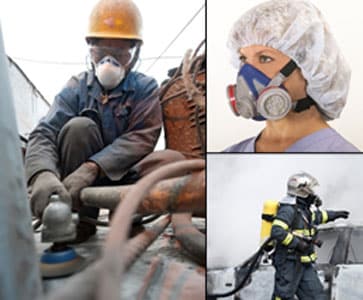Preparedness through Daily Practice: The Myths of Respiratory Protection in Healthcare
DHHS (NIOSH) Publication No. 2016-109 (March 2016)
In this document, NIOSH addresses common myths related to respiratory protection and provides information to reinforce respiratory protection program administrator responsibilities and HCW knowledge concerning the proper use of these devices so that they can be prepared for the next public health emergency and best protect themselves in daily practice.
Filtering out Confusion: Frequently Asked Questions about Respiratory Protection, User Seal Check
DHHS (NIOSH) Publication Number 2018-130 (April 2018)
The Occupational Safety and Health Administration (OSHA) (29 CFR 1910.134) requires an annual fit test to confirm the fit of any respirator that forms a tight seal on the wearer’s face before it is used in the workplace. Once a fit test has been done to determine the best respirator model and size for a particular user, a user seal check should be done every time the respirator is to be worn to ensure an adequate seal is achieved.
Filtering out Confusion: Frequently Asked Questions about Respiratory Protection, Fit Testing
DHHS (NIOSH) Publication Number 2018-129 (April 2018)
The Occupational Safety and Health Administration (OSHA) (29 CFR 1910.134) requires an annual respirator fit test to confirm the fit of any respirator that forms a tight seal on the wearer’s face before it is used in the workplace. This ensures that users are receiving the expected level of protection by minimizing any contaminant leakage into the facepiece. The following are some frequently asked questions about respiratory protection and fit testing.
Filtering out Confusion: Frequently Asked Questions about Respiratory Protection, Respirator Reuse and Extended Use
DHHS (NIOSH) Publication Number 2018-128 (April 2018)
One of the most common types of respiratory protection is the filtering facepiece respirator (FFR), which is designed to be discarded when it becomes unsuitable for further use due to considerations of hygiene, excessive resistance, or physical damage. However, due to the considerations of cost, convenience, and supply, respiratory protection program managers have great interest in the practices of reuse and extended use of National Institute for Occupational Safety and Health (NIOSH)-approved FFRs that are not damaged or soiled. The following are a few of the most frequently asked questions about respirator reuse.
A Guide to Atmosphere-Supplying Respirators
DHHS (NIOSH) Publication Number 2019-174 (September 2019)
Atmosphere-supplying respirators provide clean breathing air from a source independent of the work area. These respirators will protect wearers from many types of airborne contaminants (particles, gases, and vapors) and, in certain cases, oxygen-deficient atmospheres. There are three types of atmosphere-supplying respirators: supplied-air respirators (SARs), self-contained breathing apparatus (SCBAs), and combination SARs/SCBAs.
A Guide to Air-Purifying Respirators
DHHS (NIOSH) Publication Number 2018-176 (August 2018)
Air-purifying respirators (APRs) work by removing gases, vapors, aerosols (airborne droplets and solid particles), or a combination of contaminants from the air through the use of filters, cartridges, or canisters. These respirators do not supply oxygen from other than the working atmosphere, and therefore cannot be used in an atmosphere that is oxygen-deficient or immediately dangerous to life or health (IDLH). The appropriate respirator for a particular situation will depend on the environment and the contaminant(s).
Respirator Awareness: Your Health May Depend On It
NIOSH Publication No. 2013-138 (June 2013) Español
One of the occupational hazards in the healthcare setting is the airborne transmission of certain infectious diseases. The potential of exposure is not limited to physicians, nurses, and support personnel in direct patient care. It extends to those delivering food, cleaning patient rooms, and performing maintenance. Anyone working in areas with patients infected with airborne-transmissible diseases is potentially at risk.
NIOSH Respirator Selection Logic 2004
NIOSH Publication No. 2005-100 (October 2004)
The purpose of this Respirator Selection Logic (RSL) is to provide guidance to respirator program administrators on respirator selection that incorporates the changes necessitated by the revisions to the respirator use and certification regulations and changes in the National Institute for Occupational Safety and Health (NIOSH) policy.
NIOSH Pocket Guide to Chemical Hazards
The Pocket Guide is a source of general industrial hygiene information on several hundred chemicals/classes found in the work environment. It provides respirator recommendations for certain chemicals based on the concentrations.

